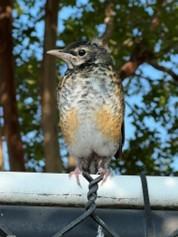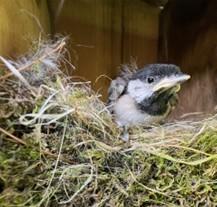Nesting Birds - Native Plants are the Key!
Few experiences in nature are as rewarding as following a family of songbirds throughout the entire nesting season. From territorial singing to gathering nesting material to laying eggs, incubating them, then nonstop feeding of nestlings, parent birds certainly have their “hands” full around the clock—and, in most cases at least, no babysitters, nannies, older sibs or grandparents to help manage the load. Incredibly, at least for our smaller birds, the entire process takes place over just six to eight weeks’ time. For most common backyard birds, we’re in the final stages of that process now in July. You don’t have to look hard to find bossy baby robins, cardinals, or catbirds following their parents around, open-mouthed and vocal about their insatiable appetites!
incubating them, then nonstop feeding of nestlings, parent birds certainly have their “hands” full around the clock—and, in most cases at least, no babysitters, nannies, older sibs or grandparents to help manage the load. Incredibly, at least for our smaller birds, the entire process takes place over just six to eight weeks’ time. For most common backyard birds, we’re in the final stages of that process now in July. You don’t have to look hard to find bossy baby robins, cardinals, or catbirds following their parents around, open-mouthed and vocal about their insatiable appetites!
If you’re fortunate enough to have birds nesting in your yard, you’ve no doubt marveled at how skillfully they weave bits of grass and twigs into a comfy ‘crib’ or smiled at the antics of awkward, always hungry fledglings begging to be fed, while exhausted parents struggle to keep up with their demands. (If you do NOT get to witness this better-than-TV entertainment every year, you clearly need a wren or bluebird box in your yard!) Children are particularly fascinated by watching the entire nesting process unfold and can’t believe how quickly featherless and blind hatchlings morph into fully feathered, flying birds. What a contrast from our species’ 20-year (or more) gradual transition into adulthood!
Whether you set up nest boxes or not, the simplest way to bring more nesting birds to your property is to plant native species of trees and shrubs. While this commonsense connection has long been suspected, we owe it to University of Delaware professor Doug Tallamy that it is now a scientifically verified fact. Tallamy, colleague Pete Marra, and graduate student Desiree Narango published a landmark study in 2018, based on several years spent documenting the nesting ecology of one of our most beloved cavity-nesting species, the Carolina Chickadee, in over 160 suburban yards in the Washington, D.C. area.
Their study was the first to link avian nesting success (number of eggs laid, rate of hatching, number of fledglings per nest, juvenile survival after fledging) to the landscape decisions that homeowners make. In each yard with nesting chickadees, they quantified how much of the surrounding vegetative community consisted of ornamental plants from other parts of the world vs. plants native to the Mid-Atlantic. The results were astounding, even surpassing the scientists’ expectations. Across the board, all measures of breeding success were significantly higher (often 30-50% higher) in yards comprised primarily of native plants. What’s more, Tallamy’s team ascertained the reason for the dramatic difference, and it was a remarkable finding for its simplicity: caterpillars!
Just as human babies need pureed foods initially, young birds cannot digest seeds nor insects with a hard exoskeleton. They need soft, easy-to-digest sources of protein and fat; caterpillars and small worms are ideal. Incredibly, Narango’s chickadees required a minimum of 6000 (!) caterpillars to successfully raise a brood of nestlings for three weeks. No wonder parent birds never seem to catch a break in their endless quest to fill hungry mouths. Caterpillars, of course, are the larval form of Lepidopterans--butterflies and moths. Most of us are aware of the symbiotic relationship between monarch butterflies and milkweed; what fewer folks know is that most of our Lepidoptera have a similar host plant to which they are specifically linked. In each case, the plant and the insect have evolved over time together, and the insect lifecycle is dependent on the presence of the specific host plant. Not all plants are created equal in this respect. Data suggests that less than 20% of our native plants support over 90% of our butterfly and moth larvae, with oaks, willows, and members of the Prunus (cherry) family leading the way by supporting the greatest diversity of Lepidoptera. Native maple trees and hickories host quite a few species, as well.
supporting the greatest diversity of Lepidoptera. Native maple trees and hickories host quite a few species, as well.
The bottom line is that while your favorite Japanese Maple, Crepe Myrtle, Bradford Pear, Paulownia tree, Burning Bush, Privet, and, ironically, Butterfly Bush may add lovely color to your yard, as plants from other parts of the world, they provide zero food value for our native caterpillars. The more of these exotic plants you have on your property, the less caterpillar biomass your yard will contain, and, hence, the less likely you’ll be to have birds nesting nearby. Consider replacing a few of these non-native ornamentals with native plant species this fall; in the long run, you’ll be inviting equally stunning colors, but in the form of fluttering butterflies and singing birds, not just flowers and leaves, into your yard.
If you’d like online advice about the best native plant choices for your yard and the specific critters you’d like to attract, visit https://www.audubon.org/native-plants or https://nativeplantfinder.nwf.org/.
Photos, by permission, from WBU Customer Lori Crisler.

